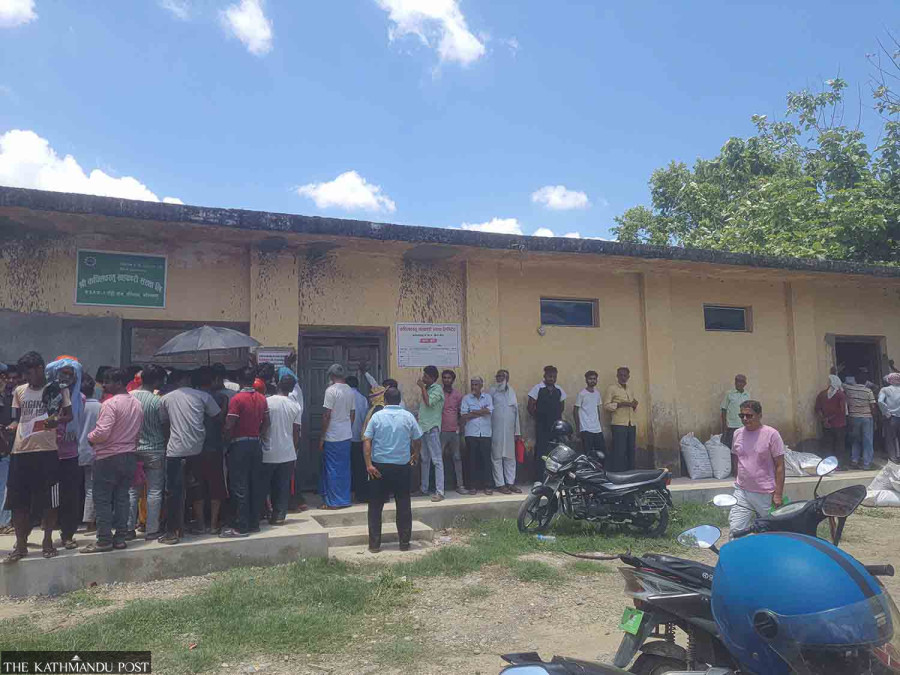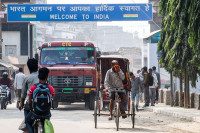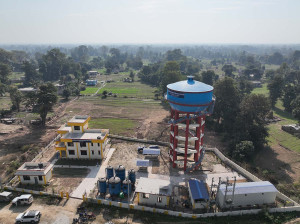Money
Fertiliser shortage pushes Lumbini farmers to lean on costly imports
As paddy planting begins, farmers across Lumbini province struggle to secure essential fertilisers, turning to expensive and less effective Indian alternatives amid government supply delays and mismanagement.
Sanju Paudel
Shyam Bahadur Chaudhary from Ward 6 of Omsatiya Rural Municipality, Rupandehi, is busy working on his field. He spends days building ridges and managing irrigation to prepare the land for sowing seeds, yet he has no idea when and how fertiliser will be available.
Desperate, he's ready to farm even without fertiliser. “Whom should I blame for this—need I bother about whose fault it is?” he says. “I don’t know if it’s the government's failure or the distribution centres’. I’m just a farmer, and I have to plant.”
Although he owns six bighas of land, the distributors ask for citizenship documents and hand out a single packet of fertiliser. Therefore, rather than wait and hope for more, he thinks it’s better to make do with whatever is available.
“I don’t go across the border—I have a sense of national pride, it doesn’t feel right. But there’s nothing here… it’s a burden. Still, we must carry on,” he says.
Without enough fertiliser, soil loses vitality. Yields drop, with paddy harvests declining in recent years. “I tried using cow dung, but if the soil doesn’t get all the necessary nutrients, you notice a decline in productivity immediately,” he adds.
“It’s worrying. This is not a new issue. Having experienced it for years, I’ve come to realise there’s no alternative—we farmers have to fight it alone.”
Rambhajan Kalwar from Ward 2 of Kapilvastu Municipality faces a similar problem.
Farming is impossible without fertiliser, but due to a short supply, he is compelled to go for Indian fertilisers. “I can’t afford to leave three or four bighas of land fallow. The Indian fertiliser isn’t very effective, and Nepal doesn’t have enough.”
According to him, fertiliser availability doesn’t match the needs of the fields, leading to recurring shortages.
Paddy farming requires fertiliser during seeding, transplanting, and multiple times during the growing cycle. Typically, fertiliser is needed four times, but farmers like Kalwar say they can’t even get enough for one application, leading to problems year after year.
He says that bringing in Indian fertiliser is a hassle, too, as the Indian police harass them during transport, while the Nepali authorities act tough too. Indian fertiliser costs around Rs2,350 per sack in local markets, but when bought in the black market, it can go up to Rs3,500, he laments.
In Lumbini Province, farmers are preparing paddies for the rice season. Some have already begun cultivation. However, farmers still don’t have much hope of getting the fertiliser they need. This is not a one-time issue—it recurs annually, pushing farmers to lean on Indian supplies.
Since cross-border procurement isn’t always easy, many farmers complain that no one speaks for them.
Ramchandra Yadav, a farmer from Ward 3 of Gulariya, Bardiya, says he is allowed only one and a half sacks of fertiliser per bigha for his 25-bigha farm.
“I need more than 25 sacks of fertiliser,” he says. “To fully fertilise my fields, I need almost 100 sacks, but I haven’t received even 10.”
Even when fertiliser is distributed through agricultural cooperatives, the quantity is the same whether you own land or not, making it harder for serious farmers to meet their needs.
Yadav says that although fertiliser is relatively easy to bring from across the nearby border, it still costs around Rs2,400 per sack—Rs50 to Rs100 more expensive than the usual price in Nepal.
Without quality fertiliser, he naturally expects his rice yields to decline. This season too, he has left his effort to fate. Having sown seeds for some of his fields, he’s waiting for fertiliser to arrive. “I don’t know how much land I’ll be able to cover,” he says.
Since different types of fertiliser are needed in specific stages, even if one type is sufficient, a shortage of another can still hurt output, he explains.
Farmers in Lumbini Province are already worried about potential losses in cultivation owing to a fertiliser shortage.
Suman Panthi, head of the Bhairahawa-based Agricultural Inputs Company Limited, says more fertiliser is available this year than in previous years.
Panthi says that 47,000 tonnes of urea—more than last year’s total—have already arrived.
“This is just the first batch. We’ve also received more DAP (Diammonium Phosphate) than last year. Getting 8,500 tonnes in the first lot is a good sign.”
As for potash, Panthi says there’s enough supply to meet demand.
The company supplies not only Lumbini Province but also districts in Sudurpaschim, Karnali, and two regions of Gandaki—Syangja and Kawasoti.
“We sell urea at Rs15 per kilogram, DAP at Rs40, and potash at Rs32. When cooperatives distribute it, they can add Re1 per kg to cover loading, unloading, and transportation costs, per local government rates. So, the price varies slightly based on logistical expenses.”
Panthi says respective local governments have failed to prioritise real farmers, worsening the shortage.
Local governments set fertiliser quotas, but problems arise when they don’t assess needs properly and misallocate supplies.
“Against a national requirement of 1.1 million tonnes, only 500,000 metric tons are being procured—so naturally, there will be shortages,” says Panthi about the nationwide supply situation. “It is the responsibility of local governments and agricultural cooperatives to ensure fertiliser is distributed according to farmers’ needs.”




 11.12°C Kathmandu
11.12°C Kathmandu













